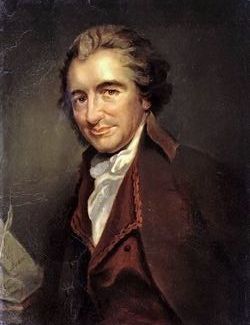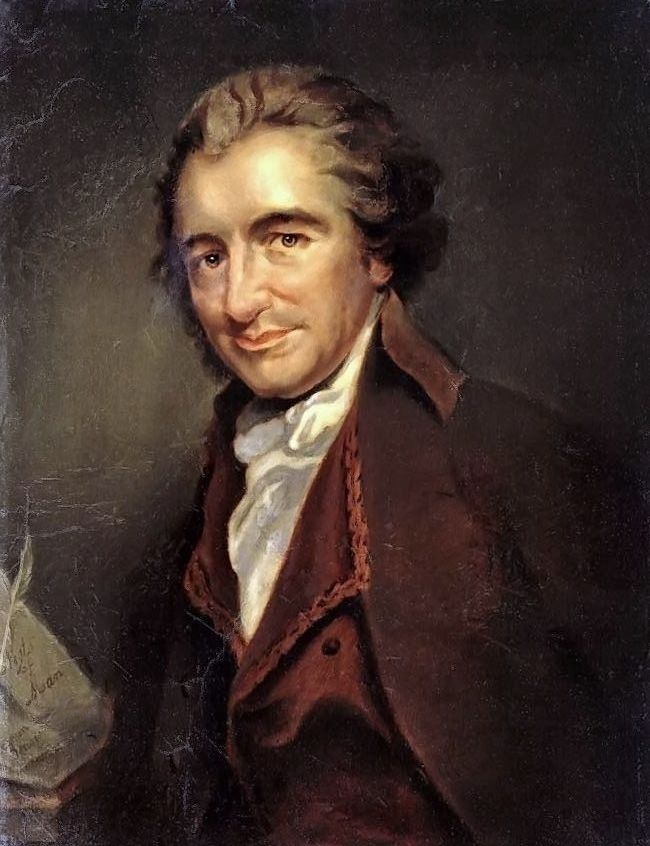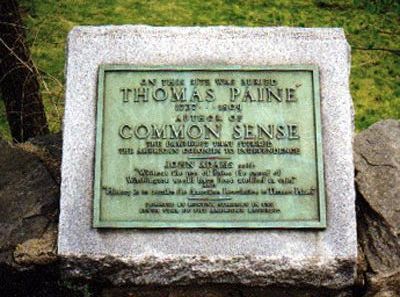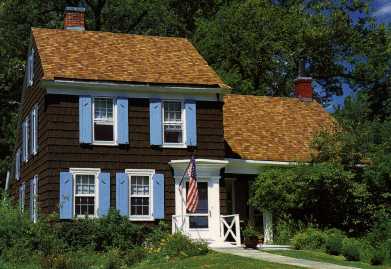American Revolutionary War Patriot, Author. Thomas Paine earned a place in American history with patriotic writings during the American Revolution. Born in England as the son of a corset maker, he only received formal education until the age of twelve. Adulthood found him with many trades, master of none. While working as a poorly-paid tax collector, he wrote his first publication in 1772, "Case of Officers of Excise," which argued for a pay increase. He met Benjamin Franklin, who convinced him to emigrate to America in 1774, where he became editor of the "Pennsylvania Magazine" and anonymously published his pamphlet "Common Sense," which was written in the language of the common man, urging immediate separation from England. He joined the Continental Army in 1776 and wrote a series of 16 papers called the "Crisis Papers," which began with the famous phrase, "These are the times that try men's souls." These publications bolstered the morale of General George Washington's Army. He also took part in the movement that produced in Pennsylvania the era's most democratic state constitution. By 1787, he had returned to Europe, defending the French Revolution movement. Charged with treason by the government of his native England, he fled to France where he was made an honorary citizen, became a delegate to a convention, and part of the drafting of the Constitution of the French Republic. His writings were translated from English to French by Sophie de Condorcet, promoting the French Revolution. Since he did not vote for the execution of King Louis XVI, he was sent to prison and barely escaped the guillotine. He promptly wrote another paper entitled "The Age of Reason," which was interpreted in America as atheistic and immoral since the piece had anti-church tones. With the support of other American patriots, Thomas Jefferson and James Monroe, he was allowed to return to the United States. In Paris in 1802, he was presented with the gift of funds to pay his debts and finance his return to the United States by Francis Burnett, a member of English Parliament, who sympathized with Paine's fate. Upon returning to his 227-acre New Rochelle farm, which had been awarded to him by the State of New York in 1784, he was ostracized from the community and abuse was heaped upon him, thus not supporting his freedom of the press or religion. He retreated to Manhattan, where he died, childless, scorned, impoverished, and denying Christianity on his deathbed. His body was returned to his farm for burial with barely a handful of mourners in attendance, with one being the coffin maker seeking payment. In 1819, a complex saga began when his remains were exhumed by a British newspaper reporter, William Cobbett, with the intention of taking the remains to England for reburial, thus saving the Paine's grave site from daily abuse and vandalism. One theory claims Paine's remains were lost in the journey, while another claims that Cobbett kept the remains in an attic trunk in England, and upon his death, his son attempted to placed Paine's bones on the auction block, but failed. It is not clear what happened to his remains after that point. People from around the world have claimed to have Paine's skeletal parts: A minister in England claims he has Paine's skull and right hand, an English woman insists she has his jawbone, and others claim to have buttons constructed from the bones. Most recently in 1990, an Australian businessman claimed to purchase Paine's skull. The Thomas Paine Museum states that the brain stem was buried in a secret location on the property. One true fact: Paine's wallet, glasses, watch, a pair of gloves, a lock of hair, and also his death mask are on display at either the museum or the adjacent Thomas Paine Cottage, which was his residence from 1803 to 1806 and is maintained by the Huguenot and New Rochelle Historical Association of New Rochelle, New York. He is the only American Founding Father who has a questionable buried site.
American Revolutionary War Patriot, Author. Thomas Paine earned a place in American history with patriotic writings during the American Revolution. Born in England as the son of a corset maker, he only received formal education until the age of twelve. Adulthood found him with many trades, master of none. While working as a poorly-paid tax collector, he wrote his first publication in 1772, "Case of Officers of Excise," which argued for a pay increase. He met Benjamin Franklin, who convinced him to emigrate to America in 1774, where he became editor of the "Pennsylvania Magazine" and anonymously published his pamphlet "Common Sense," which was written in the language of the common man, urging immediate separation from England. He joined the Continental Army in 1776 and wrote a series of 16 papers called the "Crisis Papers," which began with the famous phrase, "These are the times that try men's souls." These publications bolstered the morale of General George Washington's Army. He also took part in the movement that produced in Pennsylvania the era's most democratic state constitution. By 1787, he had returned to Europe, defending the French Revolution movement. Charged with treason by the government of his native England, he fled to France where he was made an honorary citizen, became a delegate to a convention, and part of the drafting of the Constitution of the French Republic. His writings were translated from English to French by Sophie de Condorcet, promoting the French Revolution. Since he did not vote for the execution of King Louis XVI, he was sent to prison and barely escaped the guillotine. He promptly wrote another paper entitled "The Age of Reason," which was interpreted in America as atheistic and immoral since the piece had anti-church tones. With the support of other American patriots, Thomas Jefferson and James Monroe, he was allowed to return to the United States. In Paris in 1802, he was presented with the gift of funds to pay his debts and finance his return to the United States by Francis Burnett, a member of English Parliament, who sympathized with Paine's fate. Upon returning to his 227-acre New Rochelle farm, which had been awarded to him by the State of New York in 1784, he was ostracized from the community and abuse was heaped upon him, thus not supporting his freedom of the press or religion. He retreated to Manhattan, where he died, childless, scorned, impoverished, and denying Christianity on his deathbed. His body was returned to his farm for burial with barely a handful of mourners in attendance, with one being the coffin maker seeking payment. In 1819, a complex saga began when his remains were exhumed by a British newspaper reporter, William Cobbett, with the intention of taking the remains to England for reburial, thus saving the Paine's grave site from daily abuse and vandalism. One theory claims Paine's remains were lost in the journey, while another claims that Cobbett kept the remains in an attic trunk in England, and upon his death, his son attempted to placed Paine's bones on the auction block, but failed. It is not clear what happened to his remains after that point. People from around the world have claimed to have Paine's skeletal parts: A minister in England claims he has Paine's skull and right hand, an English woman insists she has his jawbone, and others claim to have buttons constructed from the bones. Most recently in 1990, an Australian businessman claimed to purchase Paine's skull. The Thomas Paine Museum states that the brain stem was buried in a secret location on the property. One true fact: Paine's wallet, glasses, watch, a pair of gloves, a lock of hair, and also his death mask are on display at either the museum or the adjacent Thomas Paine Cottage, which was his residence from 1803 to 1806 and is maintained by the Huguenot and New Rochelle Historical Association of New Rochelle, New York. He is the only American Founding Father who has a questionable buried site.
Bio by: Linda Davis
Inscription
On this site buried Thomas Paine 1737…1805 author of COMMON SENSE, The pamphlet that stirred the American colonies to Independence, John Adams said "without the pen of Paine, the sword of Washington would have wielded in vain." "History is to ascribe the American Revolution to Thomas Paine." Donated by Rowena Stillman in the 176th year of the American Republic.
Family Members
Advertisement
See more Paine memorials in:
Records on Ancestry
Sponsored by Ancestry
Advertisement





